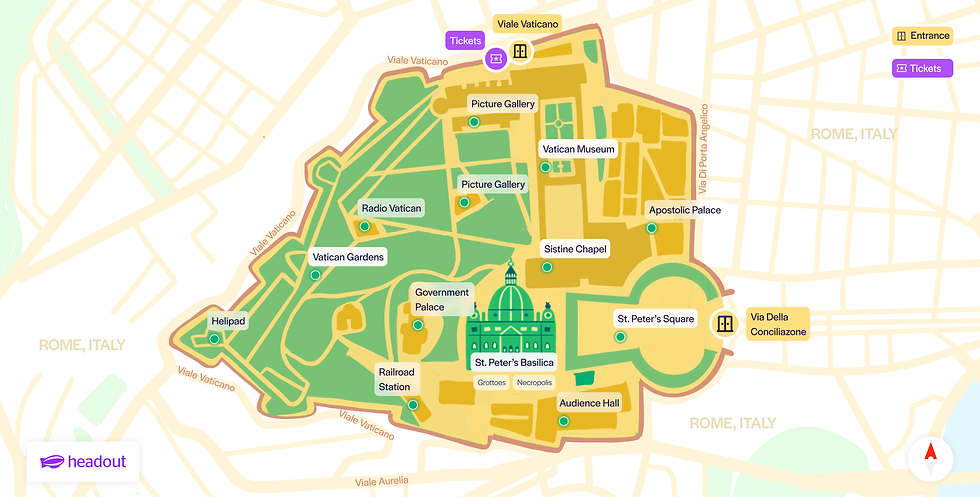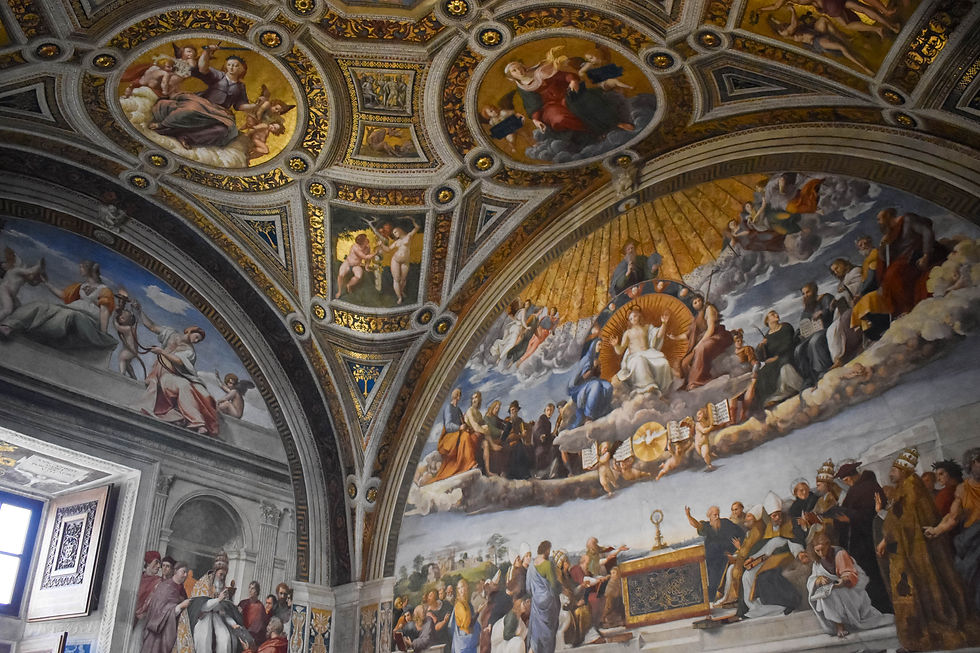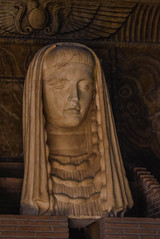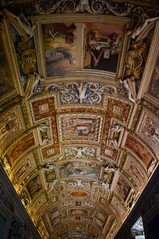The Vatican Museum
- Jo
- Jul 9
- 5 min read
The Vatican Museums, located in Vatican City, house an extensive collection of art and historical artifacts accumulated by the Catholic Church and the papacy over centuries. With over 70,000 works, including paintings, sculptures, and archaeological and ethno-anthropological items, spread across 54 galleries, they offer a journey through art history, from ancient Egypt to the Renaissance and beyond. A highlight for visitors is the Sistine Chapel.
Key aspects of the Vatican Museums:
Vast Collection:
The museums contain a vast collection of art, including ancient Egyptian artifacts, Etruscan bronzes, Renaissance paintings, and modern religious art.
Historical Significance:
The Vatican Museums trace their origins to the early 16th century, with successive popes continuing to add to the collection.
Architectural Highlights:
The museums include significant architectural spaces like the Sistine Chapel, Raphael's Rooms, and the Gallery of Maps.
Must-See Artworks:
Visitors should not miss Michelangelo's Sistine Chapel, Raphael's Rooms, and the Gallery of Maps.

Entrance to the museum is a 10-minute walk from St Peter's Square. Please make sure that you arrive in plenty of time for your allocated slot (buying tickets in advance is strongly recommended due to the vast number of visitors). As you are looking at St Peter's, take the road to the right and follow the wall around to the other side. As with anywhere in Rome, make sure you have your walking shoes on!!!. Once there, we were not waiting very long to get inside, but once inside, you have to go through security, etc. We were also told to bring ID with us.



Pinacoteca
Our first stop was the Pinacoteca courtyard, where we were met with a gorgeous view of the dome St. Peter's Basilica. From here we went into the Pinacoteca. The following is from the Vatican Museum website
"The new Vatican Pinacoteca (Art Gallery) was inaugurated on 27 October 1932 in the building especially constructed by the architect Luca Beltrami for Pius XI. It was built in the nineteenth century Square Garden, isolated and completely surrounded by avenues, in a place considered suitable for assuring the best lighting conditions for both the correct preservation of the works and their optimum aesthetic enhancement. Thus, the age-old question of the exhibition of the paintings, which were constantly moved around the Apostolic Palaces due to the lack of a setting that matched their importance, was solved. The collection contains some masterpieces of the greatest artists of the history of Italian painting, from Giotto to Fra Angelico, from Melozzo da Forlì to Perugino and to Raphael, from Leonardo to Tiziano, to Veronese, to Caravaggio, and to Crespi.

Pius-Christian Museum
The Museum was founded in 1854 by Pius IX in the Lateran Palace, and was intended to house evidence of the Christian communities of the first centuries.
The following is again, from the Museum webiste briefly describes the works on display here.
"the works - almost entirely sarcophagi with Christian imagery dating from the third to the fifth centuries - were placed in a large gallery of the Palace and divided organically into groups predominantly on a thematic basis, in relation to iconographic themes or biblical scenes, dictated by precise didactic or catechetic intentions, seeking however to maintain at least in part the chronological development of the theme"
Gregorian Egyptian Museum
I wasn't expecting a large number of the rooms to be dedicated to Egypt. However, Egypt became a part of the Roman Empire after the Roman conquest in 30 BC, following the defeat of Mark Antony and Cleopatra by Octavian (later Augustus). Before the conquest, Rome and Egypt had a complex relationship, marked by both conflict and cooperation.

Pio Clementino Museum
Here is what the museum website says about this part of the Vatican Museum.
"The Museum is called Pio Clementino after the two popes who oversaw its foundation, Clement XIV Ganganelli (1769-1774) and Pius VI Braschi (1775-1799). The museum fills several large exhibition halls which were obtained by adapting pre-existing rooms with new constructions both within and adjacent to the small Belvedere Palace of Innocent VIII (1484-92). Antique sculpture was brought here and ancient roman pieces have often had their missing parts completely restored. The neo-classical architecture was realised under the direction of Alessandro Dori, Michelangelo Simonetti, and Giuseppe Camporese and embellished by the work of a large number of painters and decorators."


The "long gallery"
The "long gallery" in the Vatican refers to the Gallery of Maps, a spectacular 120-meter-long corridor in the Vatican Museums. It's known for its detailed frescoes depicting maps of Italy, commissioned by Pope Gregory XIII and completed in 1583. The gallery is a significant example of cartography and art from the late 16th century.

Room of the Immaculate Conception
There is no better place to get a brief description of the room than from the Vatican Museum website
"Following the proclamation of the dogma of the Immaculate Conception by Pius IX, which took place on 8 December 1854, the pontiff decide to celebrate the event with a cycle of frescoes.
The pictorial decoration proceeds from the ceiling, with allegorical scenes alluding to the virtues of the Virgin; it continues along the northern wall with the homage of the continents to the Church enthroned; it continues on the west wall, devoted to the Discussion of dogma in St. Peter’s Basilica, and concludes on the east wall, with the Coronation of the Image of Mary, an event following the Proclamation, which took place in St. Peter’s. Podesti, who was present, included a self-portrait here."

The Raphael Rooms
The Raphael Rooms, also known as Stanze di Raffaello, are a suite of four rooms in the Vatican Museums, decorated with frescoes by Raphael and his school. These rooms, once part of the papal apartments, are renowned for their High Renaissance masterpieces and are a major attraction for visitors. Pope Julius II commissioned Raphael to decorate these rooms, and the work was carried out between 1508 and 1524.

Upon leaving the Raphael Rooms, we head towards the Sistine Chapel. Unfortualy, no photos are allowed to be taken in here. The Chapel itself was a lot smaller than I imagined, but still every bit as awe-inspiring. The Renaissance frescoes, most famously by Michelangelo, are just out of this world. The most iconic part of the chapel is the ceiling, painted by Michelangelo between 1508 and 1512. It depicts scenes from the Book of Genesis, including the famous "Creation of Adam. It is hard to believe that it is over 500 years old.
Bramante Staircase
The Vatican features two notable staircases: the original Bramante Staircase and the modern Bramante Staircase (also known as the Vatican Museums Staircase), both designed with a unique double helix shape. The original, commissioned by Pope Julius II, allowed for uninterrupted traffic flow for people and pack animals, while the modern one, designed by Giuseppe Momo, serves as the exit of the Vatican Museums. The modern one is the one that is easily accessible to the public and is a nice ending to a spectacular visit.


As stated, the staircase is the exit to the museum. However, there was much more to see, bits that we missed due to just how busy it was. And we did miss the gardens altogether. Yet another excuse to visit the Eternal City again.
Thanks, as always, for taking the time to read my blog.


























































Comments